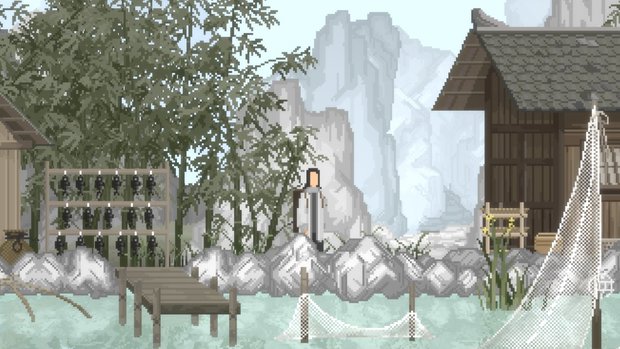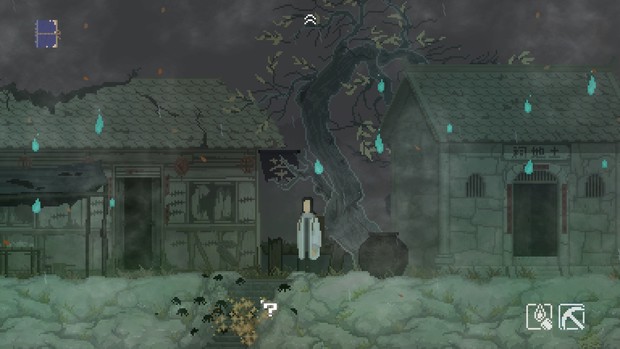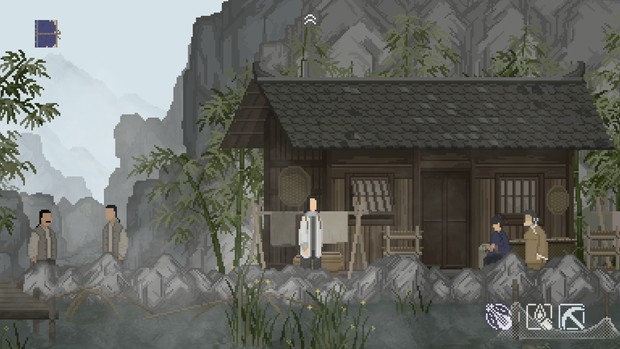The Rewinder – Ancient Chinese side-scroller is not to be overlooked

- 0 Comments
The Rewinder feels authentic. I have no deep well of knowledge of ancient Chinese culture and mythology to back that statement up, but sometimes you can just tell when your chicken has been Moo shued by a person of Southeast Asian origin or not. So if you’re the type who enjoys a side of cultural exploration with their adventure gaming, chances are you’ll be won over pretty quickly here, especially since the potential for quality is evident from the word go. And while that potential might sometimes not fulfill the high expectations set by the first half of the game, The Rewinder still remains a uniquely worthwhile experience overall.
The game begins with an introduction composed of beautiful handscroll-style paintings, exquisitely rendered in pixels. Chinese handscrolls are meant to be unfolded slowly, with the viewer pausing to appreciate each section before moving on to the next. The same principle is put into effect here, as the screen slowly pans across the images, revealing the story in sync with the spoken Mandarin language narration.
We are told that the War of Apotheosis has ended, but this has not caused peace to return. People are living and dying poorly, causing resentful ghosts to run amok. The cycle of death and rebirth has collapsed, and spirits and monsters are roaming the land. To rectify this grave situation, four guardians descended from heaven, imbuing several special children with the power of Rewinding. These Rewinders have the ability to travel back in time and change the past, allowing the disturbed souls to transition peacefully. Over time, however, the number of Rewinders has dwindled, until now there are only a few remaining.

You are Yun, who is one of these final few. After the introduction, we are greeted with a fade-in of our protagonist as he is having tea on the patio outside of his small mountain home. It is a scene set predominantly in shades of black and white, with color and warmth added by a cherry blossom tree and hanging lanterns. It bears remarking once again how immaculately the artists have been able to recreate the atmosphere and detail of handscroll art, using such an antithetically modern medium as pixels. This is the world that you will exist in for the 5-7 hours of playtime that The Rewinder provides, and the fact that all movement in the game occurs on a side-scrolling axis heavily compounds the living-handscroll effect.
After a just few sips, Yun is interrupted from his tea-drinking reverie by his celestial sidekick, Light. Apparently, there is spiritual unrest in Reed River Village. Their Guardian, Tu Di, has gone missing, and dozens of souls are not finding their way to the afterlife. The White Lotus Clan are the suspected perpetrators of these calamities, and so Yun sets off to investigate and, hopefully, set things right.
After the epically wrought heaven-and-hell setup, the mission that you are left to accomplish is actually quite provincial and intimate. As Yun (and a couple of companions whose powers can be used to assist along the way) you will travel back and forth between two neighboring villages, discovering the stories and relationships of their occupants. You will be called upon to use your Rewinder skills to divert the flow of history, avoiding tragedies and playing peacemaker—sometimes by preventing confrontations from happening in the first place. Oh, and let’s not forget the giant spiders and giant-spider-people, ostensibly agents of the White Lotus, who will be trying to send you to the afterlife at every interval.

Story-wise, The Rewinder definitely throws you in at the deep end, almost as if it expects the player to have an existing knowledge of the characters and world they live in. And yet, it really doesn’t have any such expectations. Such is the skill of the minimalistic writing that I never felt overwhelmed or lost amidst a vernacular that is liberally seasoned with unfamiliar names and terms. Anything that is not immediately understood will be explained shortly, through show or tell. The ‘show’ usually comes in the form of minute environmental details, often not even clickable, but which, if observed, will fill small niches in the story and shed a bit more light on a character, location, or situation. The contrast of these small instances of rural humanity, juxtaposed with the game’s artistic grandeur, creates a sense of place that stands as a truly impressive accomplishment.
There is one knock to be made against the visuals, and unfortunately it’s a big one, which resounds throughout other areas of The Rewinder as well: repetition. For all of the graphical splendor, there is not much in the way of variation. Outside of the two main areas that you will shuttle between, there are only a few others to be explored; and although many of these places occupy entirely different planes of existence filled with unique mythological creatures, the dark color palettes that typically define them all rarely change. Aesthetically, the result is a gradual onset of environmental dreariness. Functionally, with so little to distinguish between them, the places you go seem to blend into one another, making it a chore to remember which is which and what happened where.
This fault rears its head regarding the characters you will meet, too. They mostly dress in drab colors, and since the vintage pixel look is, by definition, a blocky one, several of them lack easily identifiable visual characteristics. Combine this with authentically short, similar Chinese names like Ming and Ying, and keeping track of who’s who becomes more difficult than it should be for those not accustomed to the culture already.

Fortunately, there is a journal in which Yun will make notes of key plot points and important clues as you go along. This helps a lot with maintaining a grasp on the situation at large, but it’s not enough if you want to fully appreciate the rich interpersonal web that exists between all of the villages’ mortal occupants and minor deities.
Sound in The Rewinder is noticeable primarily by its absence. This is an aurally sparse game, which I first attributed to a possible desire of the designers to express the muffled quietude of the mountain valleys in which the story takes place. As events develop, however, this moody detail of possibly artistic choice turns to increasingly frequent moments of cognitive dissonance. Big, important, dramatic events are happening; events which should generate sounds that represent physical and emotional resonance. Yet all we hear is gentle ambience and silence. It’s a little disturbing, especially since The Rewinder is a game that otherwise does feeling so well.
I was immediately surprised at how simple the game’s interface is. One click does everything, and, with hotspots sparse and inventory limited, there doesn’t really seem like much do to. Indeed, shortly after taking control of Yun, I became curious if and how The Rewinder’s challenge would manifest. Rest assured, it does. While far from the toughest game out there, this game has its fair share of moments that will cause players to pause in ponderation … and probably also tear out a little hair in frustration. The more reflective moments are usually found in the Rewind sequences, in which you have the power not only to go back in time, but also to read minds and influence thoughts in order to rewrite history. These sections can be replayed infinitely until you get them just right, or you can solve them ‘good enough’ and carry on with your adventuring.
Other examples of ponderous moments include thinly veiled variants of classic logic puzzles. While the game would certainly have benefited from that veil being a little less thin (by finding a way to gussy up the challenges into something a little more thematic), I thought the difficulty of these puzzles was perfectly dialed. Your enjoyment of them might vary according to your tolerance for classic activity book pen-and-paper-style problems. You know the type: drawing shapes without having to double back on your lines; deducing the correct object placement by following convoluted directions—that sort of thing. As a fan of ‘that sort of thing,’ I had plenty of fun. Even so, there were moments toward the end of the game where logic puzzle fatigue set in, and I started wishing for fewer artificial obstacles to overcome.
The Rewinder’s other challenging moments, the ones that might contribute to premature balding in some players, are the action sequences. These require an equal measure of astute observation (good), pattern memorization (okay), precise mouse clicking (bad), and equally precise timing (equally bad). Sometimes I was reminded of a point-and-click Dragon’s Lair. I’m a big proponent of pointing and clicking AND Dragon’s Lair. I’m also fond of pineapple AND pizza. But I don’t like pineapple on my pizza, and I don’t like these action sequences in The Rewinder. By utilizing one’s powers of observation, and a handful of perseverance, most gamers will be able to make it through these segments and enjoy what’s in between them, but I suspect that they will be a dealbreaker for others.
And that’s a shame, because there’s a lot of good to be experienced here, and some of it is that rare sort of good that not many games even try to deliver. Before the color palette dries up, the handscroll art style and the rural mountain sense of place it so eloquently depicts are powerfully evocative. The story can be similarly stirring, particularly the way it deals with the relationships between Yun and his friends, and those between the village dwellers whose lives—and consequentially deaths—Yun and Co. will be impacting. Small clickable elements, which seem to have no consequence other than to provide a little flavor text, are woven into the full circle as the story coalesces toward its climax, in ways that caused me to sit up in appreciation. Upon a foundation of celestial myth, we experience a tale of intense friendship, of second chances, of parents and their children coming to terms with their obligations toward one another and the world at large. These themes are heavy, but in The Rewinder they never feel burdensome, because the empathy we feel toward the characters is, though sometimes a little gut-wrenching, always a joy to experience.
Final Verdict
While undoubtedly flawed, The Rewinder is such a singular experience that I wholeheartedly recommend it to all adventure game players who have a modicum of skill and tolerance for action sequences. This is the first effort for developer Misty Mountain Studio, and it is an impressively polished debut. I’d like to see them continue to hone their craft and deliver the holistically awesome game that the first half of The Rewinder promises. Hopefully we won’t have to wait long for this delivery, and hopefully it will be a sequel, since this game does end on just a little bit of a cliffhanger.
Hot take
Authentic, different, imperfect, but very good. If you’d like a break from questing in the usual sort of places with the usual sort of suspects, give The Rewinder a try. Sometimes it will frustrate you; more often it will wow you, in ways that few others ever do.
Pros
- A rarely explored, authentic-feeling setting
- World is well-realized through beautiful pixel art
- Emotional story that usually delivers
- Puzzle difficulty is nicely measured
- Useful journal keeps track of important story details and clues
Cons
- Repetitive color palette eventually diminishes the artistic impact
- Sometimes difficult to distinguish between similar characters and locations
- A late-game over-reliance on unimaginative logic puzzles
- Abundance of dexterity-dependent sections might be a dealbreaker for some
Michael played The Rewinder on PC using a review code provided by the game’s publisher.

- Advertisement
- Help support AGH by advertising with us











0 Comments
Want to join the discussion? Leave a comment as guest, sign in or register.
Leave a comment